The X20 has a mercurial nature. It ignores boring stuff like timetables and turns up when it feels the time is right, possibly obeying a circadian rhythm all of its own. Once on board, the mystery deepens, with every journey a surprising adventure.
It’s a popular bus (perhaps because of this mysterious spirit) and seems to follow its own spontaneous route, occasionally doubling back as though it’s suddenly remembered it left the gas on. It goes down so many narrow and obscure roads you have the feeling it might be calling on people individually just in case they fancy a bus ride.
It follows its individualistic way through a heroic roll call of Northumbrian coalfield villages: Radcliffe, Hadston, Ellington, Lynemouth, Woodhorn and evokes powerful and quiet memories as it does so. This history is exemplified in the sculpture, by Tom Maley, at Ellington:
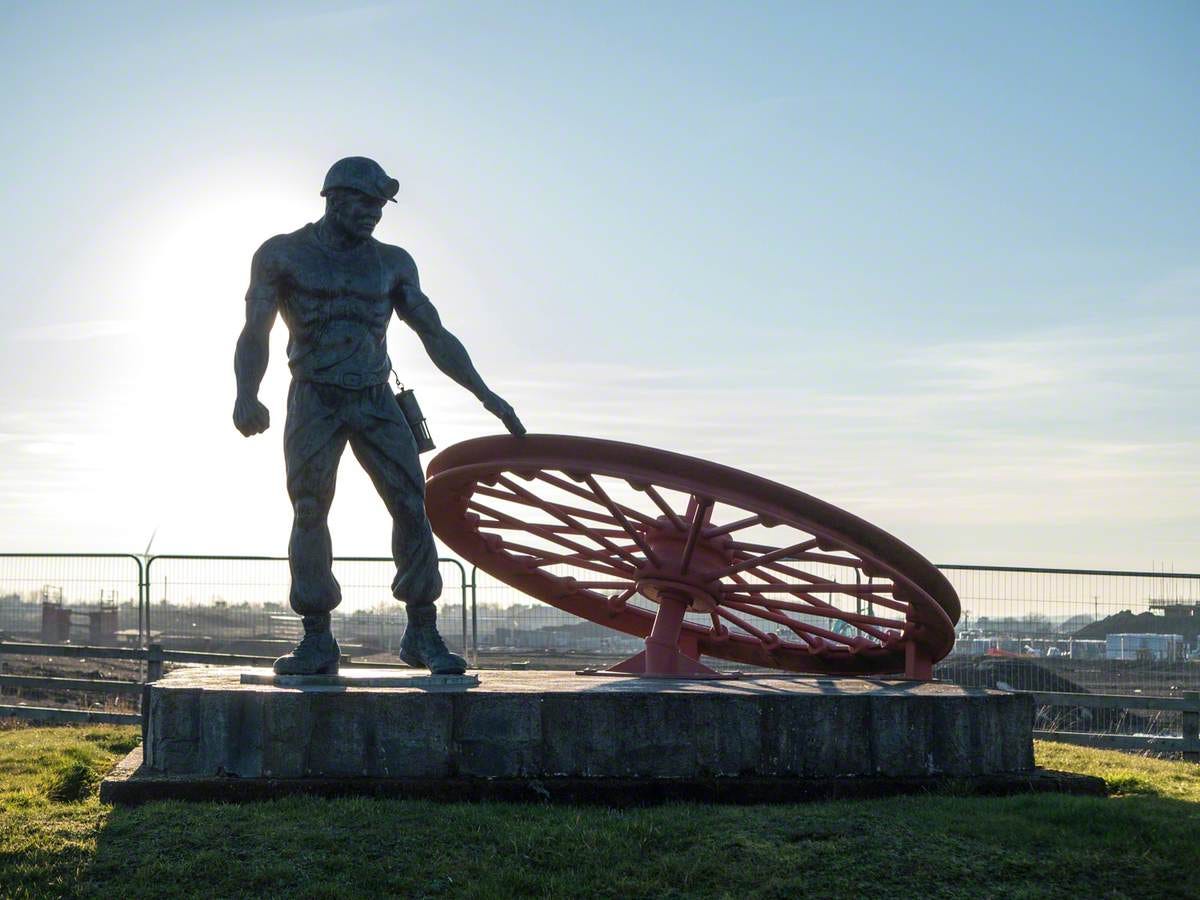
The mysteriously unworldly spirit of the X20 imbues its passengers with enigmatic qualities. The bloke sitting next to me has rolled up his ticket and stuck it behind his ear, like people used to do with pens and cigarettes. He’s wearing an old fashioned tweed cap with metal badges on it so he might have got on some time in the 1950s. Another bloke gets on at Lynemouth Mining Institute and asks the woman next to him, “Where are we?” and when she replies “Lynemouth” he gazes through the misted window in existential uncertainty and says “Aye, aye, aye I recognise it.”
The bus goes past Ashington football ground. I sometimes spend Saturday afternoons watching The Colliers here. When the wind blows freezing rain diagonally across the pitch on a cold January afternoon, you can gain a perspective on the futility of existence that might see you through the rest of the winter. There’s usually a decent match to watch as well. The Ashington ultras occupy one corner of the stand and they’ve got a young lad with an oversized cap and snare drum, which he bangs vigorously at moments of excitement or tedium (he’s not choosy). My mate reckons this drum triggers his tinnitus in ways that could send him over the edge so we go for a Twix and cup of tea at half time to help calm him down.
Ashington is a palimpsest of its past self. Everywhere you look there are glimpses of how it was in its prime as ‘the biggest pit village in the world’ with more than five thousand miners living and working there. The neo classical architecture of the old Co-op is a statement of grandeur, pride and ambition, and is now a Grade II listed building:
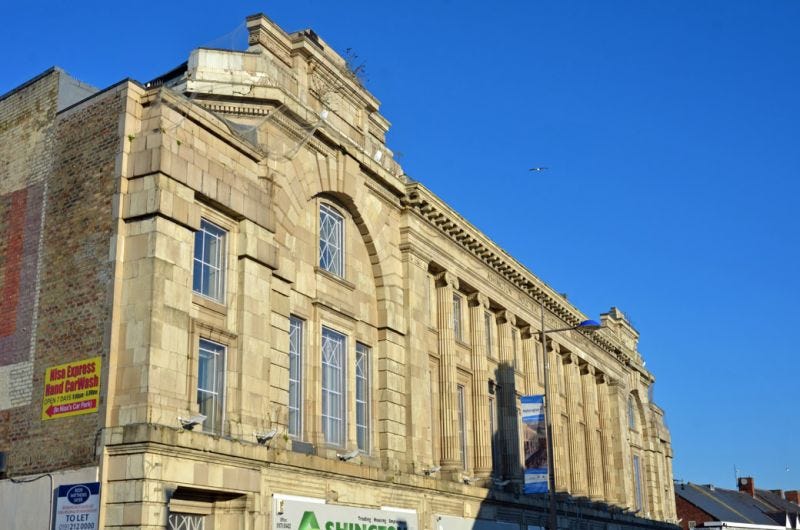
Another ghost is the Wallaw Picture Palace that opened around early 1912 with a seating capacity of 450. In 1920, the cinema was rebuilt, and re-opened with 1,100 seats. It was operated by Wallaw Pictures Ltd, owned by Walter Lawson and named by combining his first and last name. There were Wallaw cinemas all round the north east at one time.
It finally closed on 31st July 1982 with Albert Finney in Annie (which was bad enough to have closed many other cinemas up and down the country). It’s now a furniture shop and the gable end, still prominent at the bus junction, looks like it would benefit from a mural depicting its glory days.
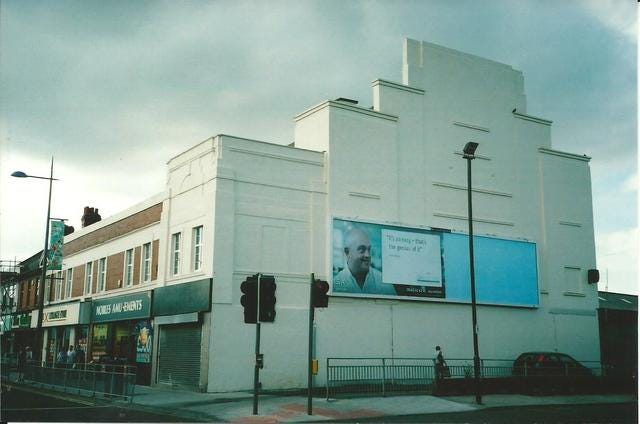
My first port of call in Ashington is a swim in the new Leisure Centre, which houses a pool, gym and library. One of the architects had the idea of decorating the windows with graffiti-style statements from locals. Nice thought but you’ve got to wonder which focus group questions elicited responses as varied as ‘See all of the World’, ‘The Flu’ and ‘Bruce Forsyth’.
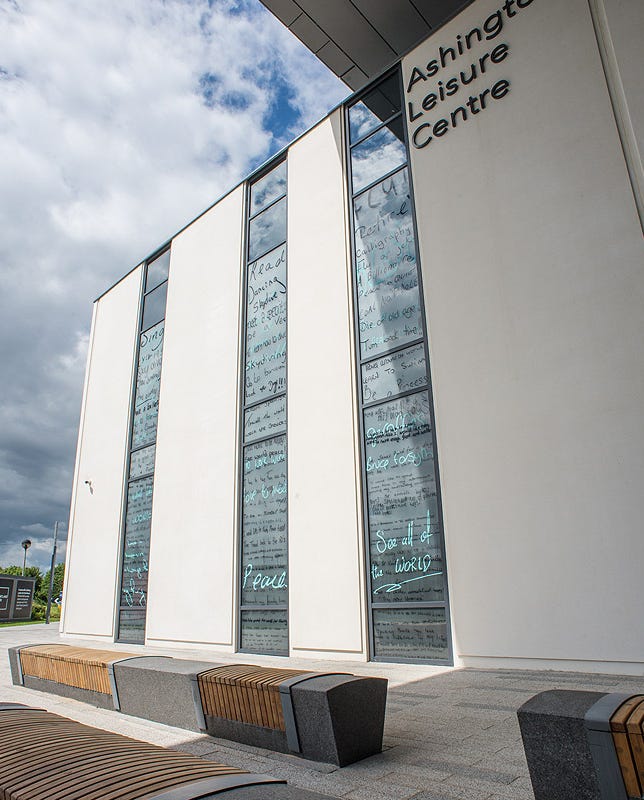
The centre has recently been taken over by some corporate leisure outfit so it’s now full of fancy logos, expensive gear and fatuous exhortations like: ‘The time is now.’ ‘Let’s do this together’ ‘Breathe deeper.’ They’ve also messed about with lane swimming. There used to be three simple categories: Slow, Medium and Fast but this new lot has introduced two additional sub-categories: Slow Medium and Fast Medium, leaving me in a state of uncertainty as to what I am (I thought I was Medium). I tried Fast Medium but some bloke swore at me, apparently suggesting I was in an over-optimistic lane. I would have remonstrated but couldn’t catch him so he might have been right.
After swimming, I head to the massive Home Bargains store next door, which is like Woolworths on multi-coloured steroids. You’d have to live in some kind of fantastic Home to want the cornucopia of Bargains on offer here. From Wind Up Flying Birds (with perhaps a nod to Murakami) to other products that are just a string of random words: Febreze 3Volution Rio Carnival Plug In Refill or Cats Vs Pickles Mystery Plush Toy Blind Bag - Chonks!
I seek refuge from this consumer overload in the Rohan Kanhai pub on the corner. It’s named after the West Indies batsman, who was brought in to play for Ashington Cricket Club in the 1964 season. A small but powerful player, Kanhai was one of the West Indies’ leading run-scorers during the 1960s and 70s. He made a fine half-century on his debut, followed by knocks of 55, 80 and 106.
By the end of June, the club had risen to second place in the league. In July, Kanhai brought the West Indian test side to Langwell Park for his benefit match. Ashington won the league title that season and the Wilson Cup. Kanhai’s contribution was a record 1,217 averaging 93.62. I remember going with my Dad to see him play, when he scored 50 in double quick time before politely edging a soft catch to a grateful first slip.
I like this pub because somebody’s always having a party in there. Today, a couple of women are sharing a bottle of chilled white wine in an ice bucket. I’m not invited so make do with all day brunch and free refills of tea. Sometimes I return to the library after lunch for a browse and a nap before enjoying the mysteries of the return journey.
Ashington, for me, is a magical place in the shamanic sense of the word: it produces an altered consciousness that helps me access healing power. Going there has seen me through difficult times when I’ve been lost and desolate. I’m grateful to the town and to the X20 for taking me there, even though I never know when it will turn up.

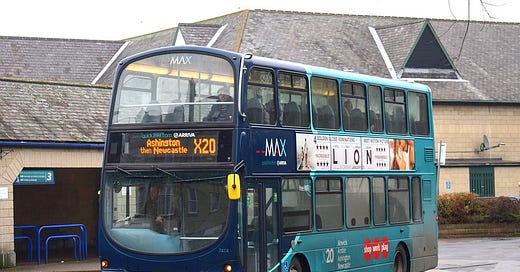



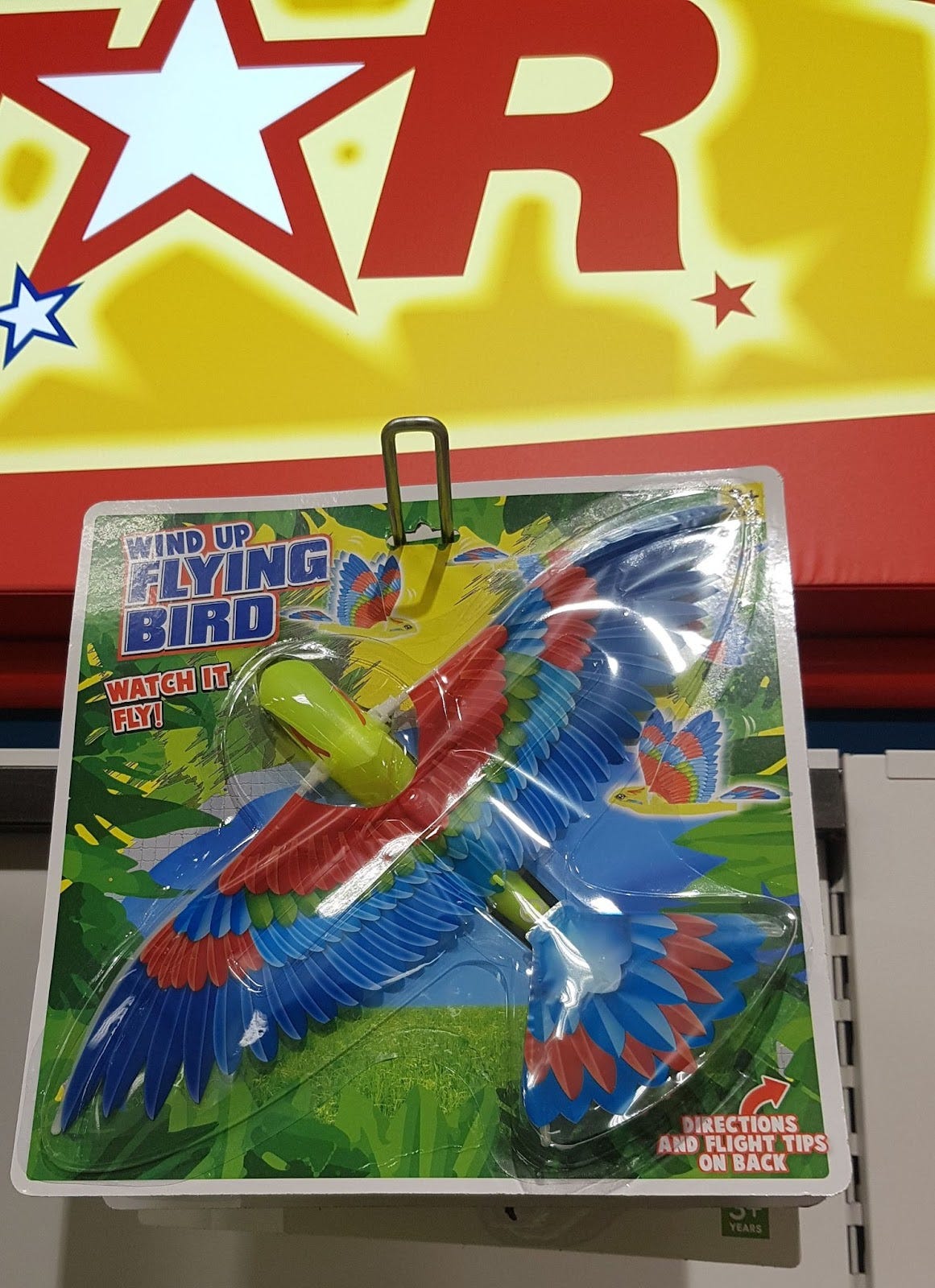
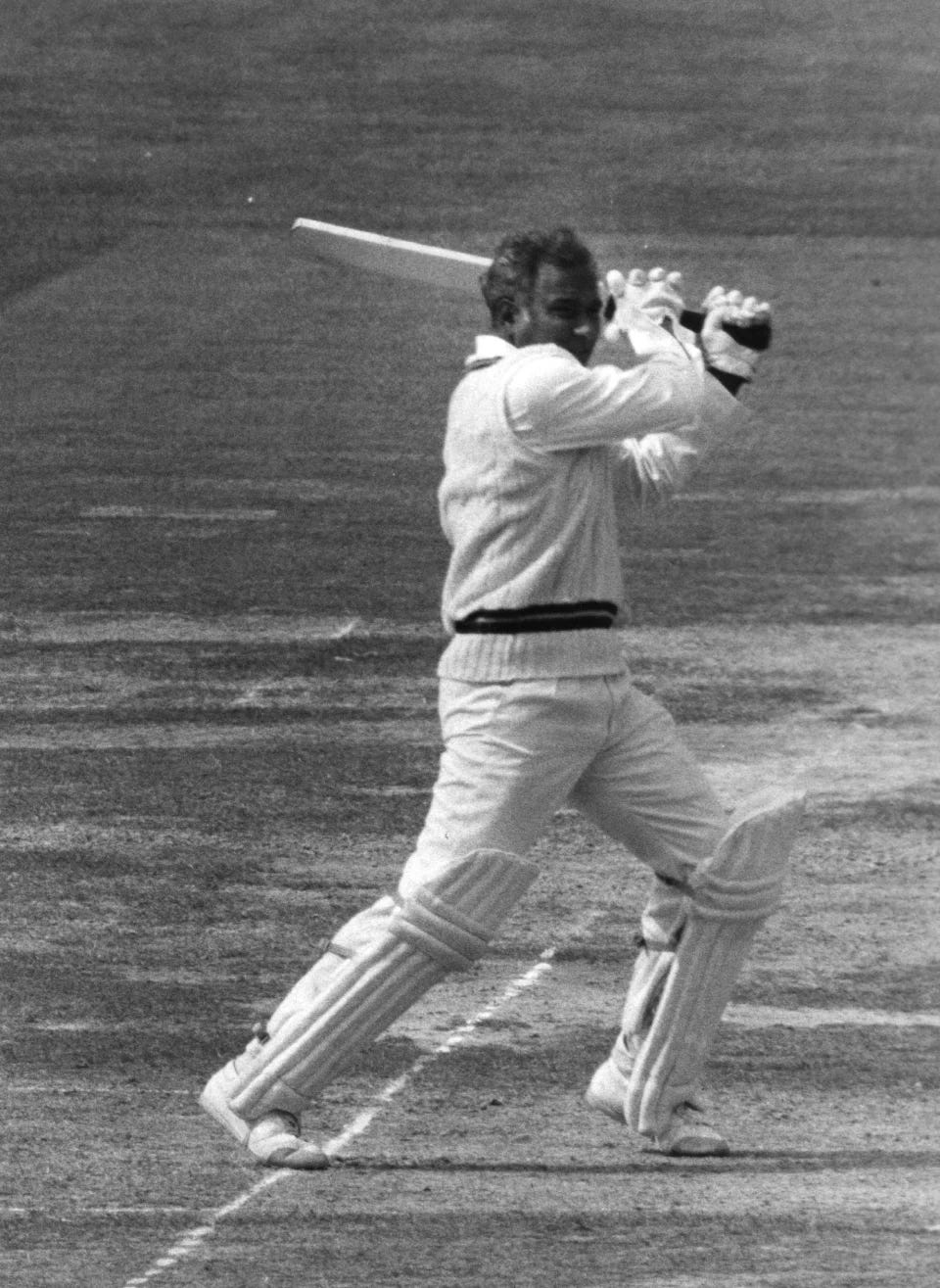
Fascinating details. I especially like how you turn the bus into a living chacter of its own!
I loved reading this Allan. You took me on the journey and it was very enjoyable!